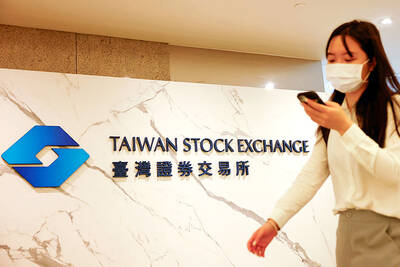The nation’s exports rose 12.1 percent from a year earlier to US$25.34 billion last month, advancing at the fastest pace in nearly four years, as demand for electronic components used in latest-generation technology remains strong ahead of Western and Lunar New Year holidays, the Ministry of Finance said yesterday.
The pickup, accelerating from a 9.4 percent increase a month earlier, confirms a stable recovery for the nation’s export-oriented economy, which might have fared better than forecast last month, the ministry said.
“Exports are set to recover faster than projected for this quarter and beyond thanks to strong demand for smartphones and the latest electronic components,” Department of Statistics Director-General Beatrice Tsai (蔡美娜) said.
Exports to all destinations improved as more partners emerged from a global slowdown, while all product categories except transportation tools registered positive movements, Tsai said.
Growth momentum was particularly noticeable in China and ASEAN markets, which accounted for 83 percent of the bounce, according to the ministry’s report, suggesting that Chinese smartphones are catching up in popularity with Apple Inc’s iPhone series.
Exports of electronic components rose 26.9 percent to US$8.79 billion, while semiconductor shipments grew 35.3 percent to US$7.54 billion, the report said.
Optical products, mainly camera lenses used in hand-held devices, gained 12.6 percent to US$1.09 billion, it said.
Exports of mineral products increased 8.2 percent to US$1.01 billion, ending years of decline caused by cheaper crude oil prices, the report said.
Imports, also a crucial economic gauge, as most result from export needs, grew 3 percent to US$21.07 billion — as local semiconductor firms aggressively acquired new equipment to update technology — more than offsetting the decline in car and smartphone imports, Tsai said.
The latest figures indicated a trade surplus of US$$4.27 billion, nearly double the level a year earlier, the report said.
China bought NT$10.71 billion (US$335.7 million) worth of goods from Taiwan, an increase of 19 percent from a year earlier and accounting for 42.3 percent of all shipments, the report said.
Shipments to ASEAN grew 13.5 percent to US$4.6 billion, while exports to the US and Europe increased 9.1 percent and 1.9 percent to US$2.96 billion and US$2.18 billion respectively, the report said.
While demand for the Christmas season might have plateaued, inventory need ahead of the Lunar New Year is gaining speed, Tsai said.
The Lunar New Year holidays are from Jan. 27 to Feb. 1 next year.

ADVANCED: Previously, Taiwanese chip companies were restricted from building overseas fabs with technology less than two generations behind domestic factories Taiwan Semiconductor Manufacturing Co (TSMC, 台積電), a major chip supplier to Nvidia Corp, would no longer be restricted from investing in next-generation 2-nanometer chip production in the US, the Ministry of Economic Affairs said yesterday. However, the ministry added that the world’s biggest contract chipmaker would not be making any reckless decisions, given the weight of its up to US$30 billion investment. To safeguard Taiwan’s chip technology advantages, the government has barred local chipmakers from making chips using more advanced technologies at their overseas factories, in China particularly. Chipmakers were previously only allowed to produce chips using less advanced technologies, specifically

BRAVE NEW WORLD: Nvidia believes that AI would fuel a new industrial revolution and would ‘do whatever we can’ to guide US AI policy, CEO Jensen Huang said Nvidia Corp cofounder and chief executive officer Jensen Huang (黃仁勳) on Tuesday said he is ready to meet US president-elect Donald Trump and offer his help to the incoming administration. “I’d be delighted to go see him and congratulate him, and do whatever we can to make this administration succeed,” Huang said in an interview with Bloomberg Television, adding that he has not been invited to visit Trump’s home base at Mar-a-Lago in Florida yet. As head of the world’s most valuable chipmaker, Huang has an opportunity to help steer the administration’s artificial intelligence (AI) policy at a moment of rapid change.

The New Taiwan dollar is on the verge of overtaking the yuan as Asia’s best carry-trade target given its lower risk of interest-rate and currency volatility. A strategy of borrowing the New Taiwan dollar to invest in higher-yielding alternatives has generated the second-highest return over the past month among Asian currencies behind the yuan, based on the Sharpe ratio that measures risk-adjusted relative returns. The New Taiwan dollar may soon replace its Chinese peer as the region’s favored carry trade tool, analysts say, citing Beijing’s efforts to support the yuan that can create wild swings in borrowing costs. In contrast,

TARIFF SURGE: The strong performance could be attributed to the growing artificial intelligence device market and mass orders ahead of potential US tariffs, analysts said The combined revenue of companies listed on the Taiwan Stock Exchange and the Taipei Exchange for the whole of last year totaled NT$44.66 trillion (US$1.35 trillion), up 12.8 percent year-on-year and hit a record high, data compiled by investment consulting firm CMoney showed on Saturday. The result came after listed firms reported a 23.92 percent annual increase in combined revenue for last month at NT$4.1 trillion, the second-highest for the month of December on record, and posted a 15.63 percent rise in combined revenue for the December quarter at NT$12.25 billion, the highest quarterly figure ever, the data showed. Analysts attributed the